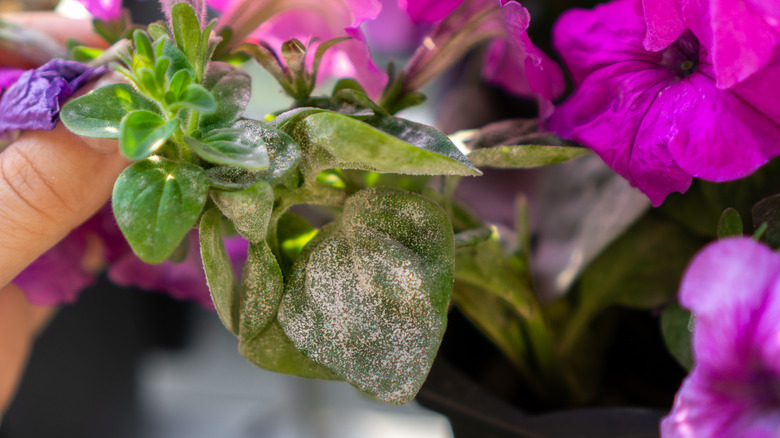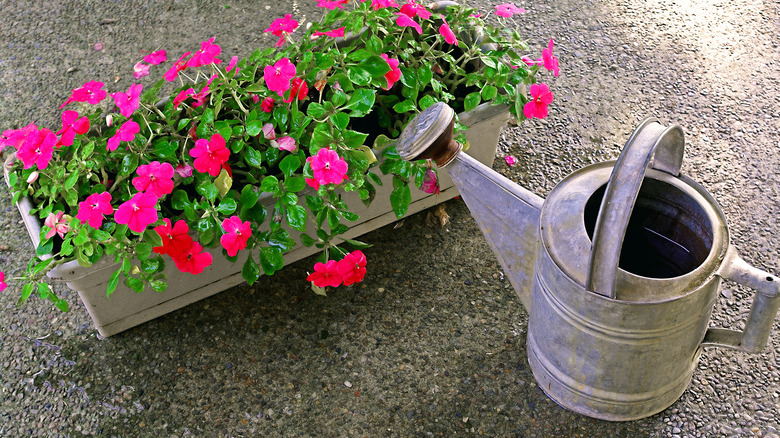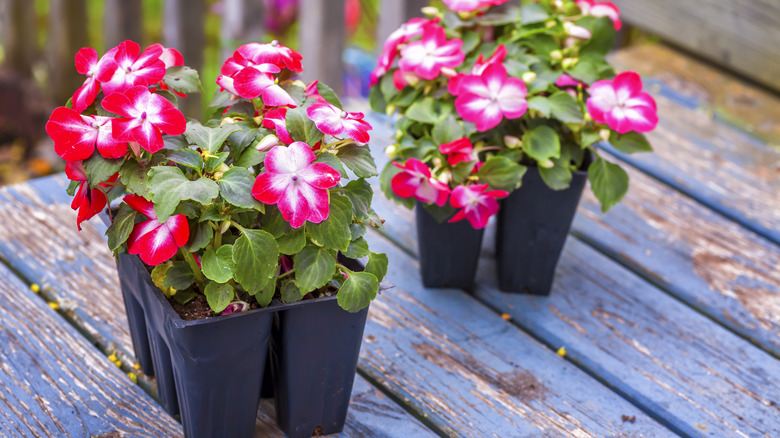Plant Rescue: What Downy Mildew On Impatiens Looks Like And How To Save It
Thousands of people enjoy gardening as a way to relax and connect with nature. In fact, 55% of American households maintain some form of a garden, according to Garden Pals. Although it is a fun and relaxing activity, gardening isn't always sunshine and rainbows. It's easy to stress over your watering schedule, sunlight and planting seasons, and of course, disease prevention. To no fault of their own, almost every gardener will experience a wave of disease at some point, especially with fickle flowers like impatiens. Have you noticed odd spots and fuzzy leaves on your impatiens? Are your plants slowly dropping their leaves and flowers? Your garden could have an outbreak of impatiens downy mildew.
Downy mildew refers to a disease caused by a broad category of pathogenic fungi. Several fungi species can cause downy mildew in a wide variety of plants, from cucumbers to sorghum and grapes. Impatiens downy mildew, specifically, is a disease caused by the fungal microorganism, Plasmopara obducens. This microorganism exclusively infects impatiens plants, including native jewelweeds and garden varieties. The disease can cause light mottled spots and pale fuzzy growth on leaves or cause them to droop and curl in on themselves (via the University of Maryland). Eventually, the plant will defoliate or drop its leaves, leaving behind a barren stem.
Downy mildew spreads by wind, water, and soil
One of the things that makes impatiens downy mildew so hard to control is that Plasmopara obducens releases both airborne and waterborne spores (via Michigan State University). Once spores land and infect an impatiens, oospores develop in the leaves. These oospores can survive in the soil through the winter, giving the fungus a total of three ways to continue spreading: wind, water, and soil. It's difficult to determine a timeline once the infection starts; Plasmopara obducens can lay dormant in the impatiens tissue until conditions are ideal, then explode into full-blown downy mildew. White "fuzz" can seemingly appear overnight, but these are actually spores from the already-residing Plasmopara obducens.
Like a root system for fungi, mycelia will quickly spread through the plant's tissue and begin sapping nutrients. As it's depleted of nutrients, the impatiens plant will essentially rot, dropping its leaves and flowers. Any new growth will be stunted or even malformed. Infected plants can die within a few weeks of infection, but in the meantime, they are a serious threat to neighboring impatiens. As you might imagine, this disease spreads quickly from plant to plant, so it's important to gain control of the spread as soon as possible.
Stopping and preventing impatiens downy mildew
A sudden explosion of downy mildew is a sad sight for a gardener. Unfortunately, fungicides are ineffective against Plasmopara obducens. The only way to eliminate downy mildew is to remove and dispose of infected plants. Even if your impatiens seem to make a miraculous recovery from downy mildew, you should still remove them. Mary Hausbeck, the ornamental plant pathology expert at Michigan State University, explains that a sudden period of hot and dry weather may stunt the infection. Because the disease stops spreading temporarily, the plant may produce new, seemingly healthy leaves. However, the fungi still exist in the impatiens, and the only way to prevent downy mildew from returning is to discard the whole plant.
Prevention is the best option for handling impatiens downy mildew. Luckily, prevention methods are fairly easy to follow. Spores typically infect the leaves of impatiens first, so avoid wetting the leaves and try to soak just the soil. The exact lifespan for Plasmopara obducens oospores is unknown, but other similar species can remain in soil for up to 10 years (via the University of Massachusetts Amherst). For this reason, always quarantine new impatiens before planting and avoid planting them in previously infected soil. If you're concerned about downy mildew but you simply must have impatiens in your garden, hybrid impatiens from New Guinea (Impatiens hawkerii) appear to be resistant to the disease (via the University of Wisconsin).


